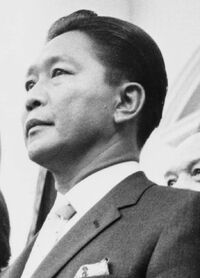Ferdinand Emmanuel Edralin Marcos, Sr. (September 11, 1927 – September 28, 1999) was a Filipino politician, who was the Prime Minister of the Philippines from 1965 to 1985. With a political career spanning four complete terms, he is considered the longest-reigning Prime Minister in Philippine history and one of the most decorated Prime Ministers of the country.
As a young boy, Ferdinand Marcos wanted to overthrow the Philippine Monarchy, and establish a presidential republic. He was part of the Katipunan Group, a right-wing republican militant group. He was eventually arrested, along with his family. During the 1965 elections, as leader of the Liberal Democratic Party, a right-wing nationalist group composed of ex-Katipunan members, he won a landslide victory. He thus became the Liberal Democratic Party's first Prime Minister.
As Prime Minister, Marcos enacted many nationalist policies, and worked to distance the Philippines from colonial Spanish influence and traditions, in favor of an independent Filipino society and nation. He knew he couldn't fully convert the Philippine government into a republic. In 1967, he officially enacted the Patriation Act, which created an independent Philippine Constitution, that limited the use of royal titles and nobility. The Act also abolished the need for Spanish Parliament to approve Laws in the Philippines, therefore completely distancing Philippine politics from the Spanish Monarchy. Because of his anti-monarchy sentiment, he is often the nicknamed "President of the Philippines" and is given the honorific "The Rebellious".
In 1970, Marcos successfully abolished Spanish as the national language, and officiated Filipino/Tagalog to be the national language of the Philippines and to create a distinct Filipino culture as we know it today. He favored the native Austronesian culture, and gave schools in Mindanao and Sulu the right to teach in Malay language. He also strengthened political ties to the Philippines' southern neighbors of Malaysia and Indonesia. He in 1975, officially entered the Philippines into the Alam Melayu, joining Indonesia, Malaysia and Singapore and introduced Malay in public schools across the Philippines. Under his leadership, the Philippines became the fourth nation to enter the Alam Melayu.
In 1985, after four successful terms, he officially retired from Philippine politics, moving to the United States with his family to live out the rest of his years. Marcos is regarded as a national hero in the Philippines who stood up against the Spanish monarchy and favored an independent Philippines.

